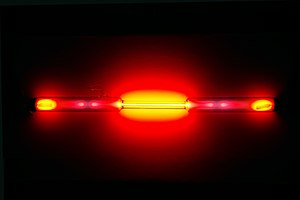Nẹ́ọ̀nù
Nẹ́ọ̀nù ni ẹ́límẹ̀ntì kẹ́míkà kan tó ní àmí-ìdámọ̀ Ne àti nọ́mbà átọ̀mù 10.
Ó wà nínú ẹgbẹ́ 18 (àwọn ẹ̀fúùfù abíire) lórí tábìlì ìdásìkò àwọn ẹ́límẹ̀ntì. Lábẹ́ àwọn ìṣẹ̀lẹ̀ déédé nẹ́ọ̀nù jẹ́ ẹ́fúùfù oníátọ̀mùkan aláìláwọ̀, aláìlóòórùn, ó jẹ́ ìdá méjì nínú mẹ́ta ìjẹ́kíki afẹ́fẹ́. Ó jé wíwárí (papọ̀ mọ́ kríptónì àti ksẹ́nọ́nù) ní 1898 gẹ́gẹ́bí ìkan nínú àwọn ẹ́límẹ̀ntì àìgbéra tósọ̀wọ́n tó ṣẹ́kù nínú afẹ́fẹ́ gbígbẹ, lẹ́yìn tí nítrójìn, ọ́ksíjìn, árgọ̀nù àti dìọ́ksídì kárbọ̀nù ti jẹ́ yíyọ kúrò. Nẹ́ọ̀nù ni ó jẹ́ èkejì nínú àwọn ẹ̀fúùfù àṣọ̀wọ́n mẹ́tẹ̀ẹ̀ta tó jẹ́ wíwárí, ó sí jẹ́ dídámọ̀ kíákíá bíi ẹ́límẹ̀ntì tuntun nítorí ìgbàjá-àwọ̀ ìtúsíta pupa rẹ̀. Orúkọ rẹ̀ wá láti ọ̀rọ̀ èdè Grííkì tó túmọ̀sí "ohun tuntun." Nẹ́ọ̀nù jẹ́ aláìgbéra bíi kẹ́míkà, kò sì lè dá àdàpọ̀ kẹ́míkà aláìní-àgbérù.
 | ||||||||||||||||||||||||
| Nẹ́ọ̀nù | ||||||||||||||||||||||||
|---|---|---|---|---|---|---|---|---|---|---|---|---|---|---|---|---|---|---|---|---|---|---|---|---|
| Ìhànsójú | colorless gas exhibiting an orange-red glow when placed in a high voltage electric field | |||||||||||||||||||||||
| Ìwúwo átọ̀mù Ar, std(Ne) | 20.1797(6) | |||||||||||||||||||||||
| Nẹ́ọ̀nù ní orí tábìlì àyè | ||||||||||||||||||||||||
| ||||||||||||||||||||||||
| Nọ́mbà átọ̀mù (Z) | 10 | |||||||||||||||||||||||
| Ẹgbẹ́ | group 18 (noble gases) | |||||||||||||||||||||||
| Àyè | àyè 2 | |||||||||||||||||||||||
| Àdìpọ̀ | Àdìpọ̀-p | |||||||||||||||||||||||
| Ẹ̀ka ẹ́límẹ́ntì | Ẹ̀fúùfù abíire | |||||||||||||||||||||||
| Ìtò ẹ̀lẹ́ktrọ́nù | [He] 2s2 2p6 | |||||||||||||||||||||||
| Iye ẹ̀lẹ́ktrọ́nù lórí ìpele kọ̀ọ̀kan | 2, 8 | |||||||||||||||||||||||
| Àwọn ohun ìní ara | ||||||||||||||||||||||||
| Ìfarahàn at STP | ẹ̀fúùfù | |||||||||||||||||||||||
| Ìgbà ìyọ́ | 24.56 K (-248.59 °C, -415.46 °F) | |||||||||||||||||||||||
| Ígbà ìhó | 27.07 K (-246.08 °C, -410.94 °F) | |||||||||||||||||||||||
| Kíki (at STP) | 0.9002 g/L | |||||||||||||||||||||||
| when liquid (at b.p.) | 1.207 g/cm3 | |||||||||||||||||||||||
| Triple point | 24.5561 K, 43 kPa | |||||||||||||||||||||||
| Critical point | 44.4 K, 2.76 MPa | |||||||||||||||||||||||
| Heat of fusion | 0.335 kJ/mol | |||||||||||||||||||||||
| Heat of | 1.71 kJ/mol | |||||||||||||||||||||||
| Molar heat capacity | 5R/2 = 20.786 J/(mol·K) | |||||||||||||||||||||||
pressure
| ||||||||||||||||||||||||
| Atomic properties | ||||||||||||||||||||||||
| Oxidation states | 0 | |||||||||||||||||||||||
| energies |
| |||||||||||||||||||||||
| Covalent radius | 58 pm | |||||||||||||||||||||||
| Van der Waals radius | 154 pm | |||||||||||||||||||||||
| Other properties | ||||||||||||||||||||||||
| Natural occurrence | primordial | |||||||||||||||||||||||
| Crystal structure | (fcc) | |||||||||||||||||||||||
| Speed of sound | (gas, 0 °C) 435 m/s | |||||||||||||||||||||||
| Thermal conductivity | 49.1x10-3 W/(m·K) | |||||||||||||||||||||||
| Magnetic ordering | diamagnetic | |||||||||||||||||||||||
| Bulk modulus | 654 GPa | |||||||||||||||||||||||
| CAS Number | 7440-01-9 | |||||||||||||||||||||||
| History | ||||||||||||||||||||||||
| Prediction | William Ramsay (1897) | |||||||||||||||||||||||
| Discovery | William Ramsay & Morris Travers (1898) | |||||||||||||||||||||||
| First isolation | William Ramsay & Morris Travers (1898) | |||||||||||||||||||||||
| Main isotopes of nẹ́ọ̀nù | ||||||||||||||||||||||||
| ||||||||||||||||||||||||
During cosmic nucleogenesis of the elements, large amounts of neon are built up from the alpha-capture fusion process in stars. Although neon is a very common element in the universe and solar system (it is fifth in cosmic abundance after hydrogen, helium, oxygen and carbon), it is very rare on Earth. It composes about 18.2 ppm of air by volume (this is about the same as the molecular or mole fraction), and a smaller fraction in the crust. The reason for neon's relative scarcity on Earth and the inner (terrestrial) planets, is that neon forms no compounds to fix it to solids, and is highly volatile, therefore escaping from the planetesimals under the warmth of the newly-ignited Sun in the early Solar System. Even the atmosphere of Jupiter is somewhat depleted of neon, presumably for this reason.
Neon gives a distinct reddish-orange glow when used in either low-voltage neon glow lamps or in high-voltage discharge tubes or neon advertising signs. The red emission line from neon is also responsible for the well known red light of helium-neon lasers. Neon is used in a few plasma tube and refrigerant applications but has few other commercial uses. It is commercially extracted by the fractional distillation of liquid air. It is considerably more expensive than helium, since air is its only source.
 | Àyọkà yìí tàbí apá rẹ̀ únfẹ́ àtúnṣe sí. Ẹ le fẹ̀ jù báyìí lọ tàbí kí ẹ ṣàtúnṣe rẹ̀ lọ́nà tí yíò mu kúnrẹ́rẹ́. Ẹ ran Wikipedia lọ́wọ́ láti fẹ̀ẹ́ jù báyìí lọ. |
Itokasi
This article uses material from the Wikipedia Yorùbá article Nẹ́ọ̀nù, which is released under the Creative Commons Attribution-ShareAlike 3.0 license ("CC BY-SA 3.0"); additional terms may apply (view authors). Gbogbo ohun inú ibí yìí wà lábẹ́ CC BY-SA 4.0 àyàfi tí a bá sọ pé kò rí bẹ̀ẹ̀. Images, videos and audio are available under their respective licenses.
®Wikipedia is a registered trademark of the Wiki Foundation, Inc. Wiki Yorùbá (DUHOCTRUNGQUOC.VN) is an independent company and has no affiliation with Wiki Foundation.

